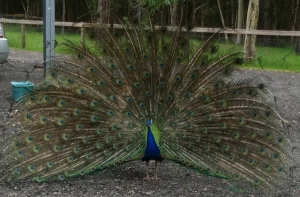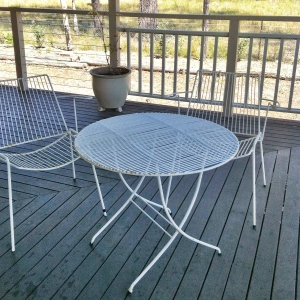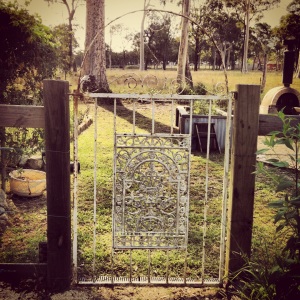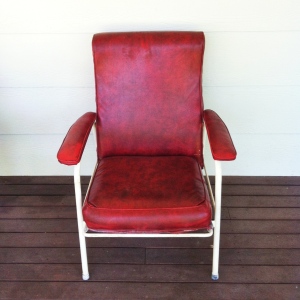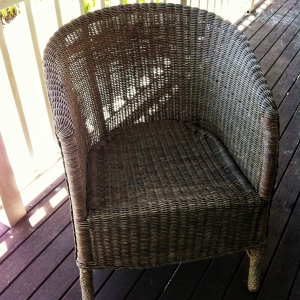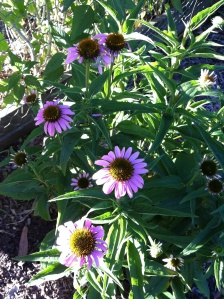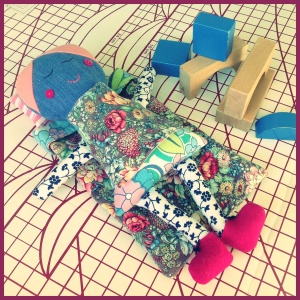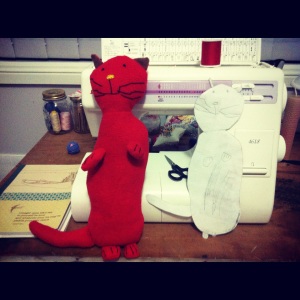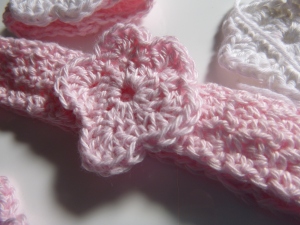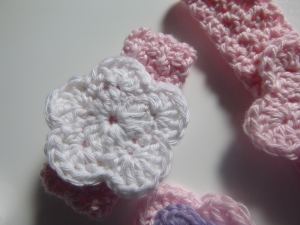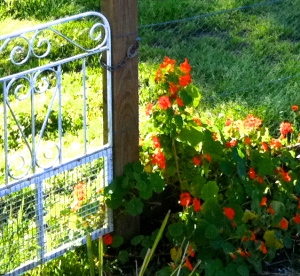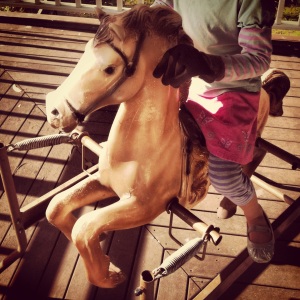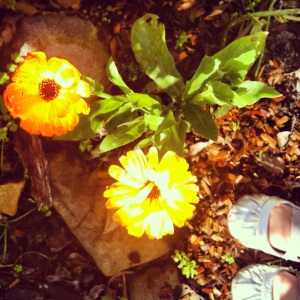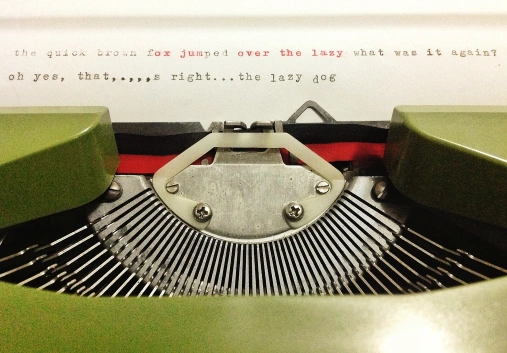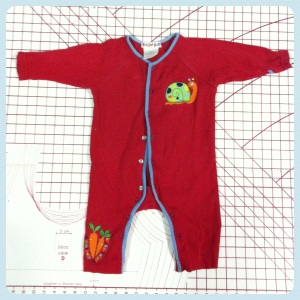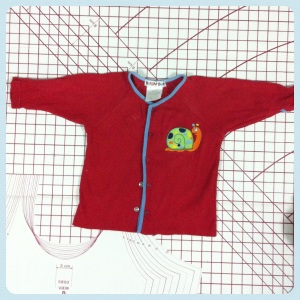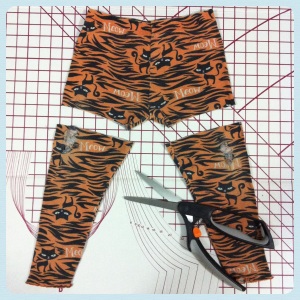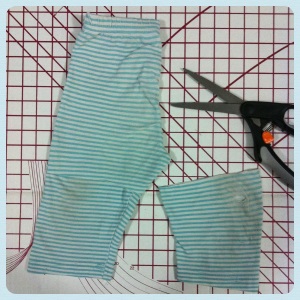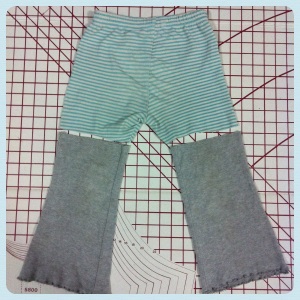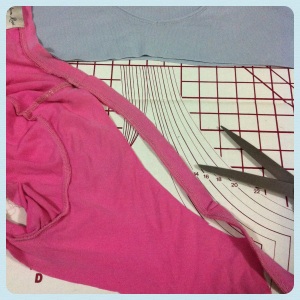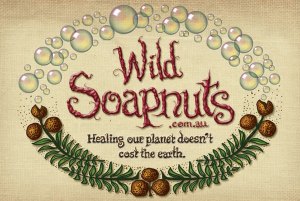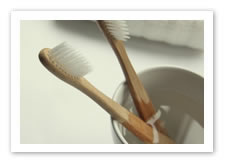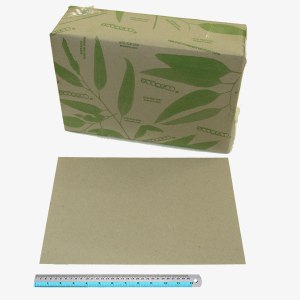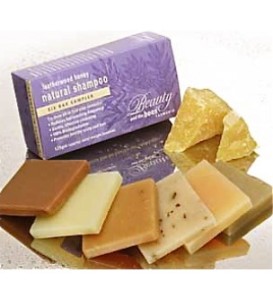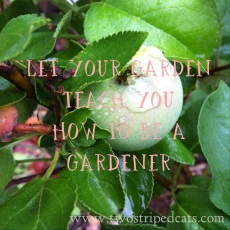My poor little blog has been somewhat neglected of late. Sorry about that. My body and mind have been exhausted by Master J developing into a spirited and energetic toddler. Nature’s plan for female humans to begin reproducing in their teens is completely logical in hindsight. I certainly could use some of my teenage (or even twentage) energy and physical condition in keeping pace with my one-year-old. And four-year-old for that matter. But then I suppose at thirty-something I have gained extra wisdom to help me get by. Maybe. I sure could do with more strength and vitality though. Anyway.
Much of my time and creative thoughts have been taken up by a challenging bathroom renovation that is happening at my old abode. More on that later I hope. (Sooner rather than later would be good.) But it’s actually this recent project that has led me to the topic of this post.
I’ve been spending many weekends at our semi-rural bushland property due to the reno (if you read about my blog you’ll see we’ve been separated for a short while…soon to be permamently reunited though…yay)! We’ve been blessed with some charming weather. And invariably along with that descends the feathered friends brigade!
These shots were all taken last Sunday on my iPhone. First I was greeted, upon opening the blinds at 7.30am, by a gang of six sulphur-crested cockies and corellas. I’m not sure why they had come together. But there they were having an early morning party in our back garden.

Later and throughout the day we were entertained with the antics and laughter of our resident kookaburras. At one time there were five sitting around the front garden. This youngster was courageous enough to venture so close that I could almost touch him. In Australia we often take these iconic birds for granted. But when given the chance to observe them close-up I get tingles down my spine. Have you ever noticed how they can sit perfectly still watching from a vantage point and then in a flash retrieve a wriggling earthworm from the soil? Or heard them chatter to one another quietly and quite different to the typical laughter that they are reknowned for? Ever looked a kooka in the eye, front-on? What an adorable sight.

And finally our other special visitors. The butcherbirds. One of my favourite bird species. Not so much because of appearances, although I do think they’re beautiful to look at. Not for their dining habits, although they are very clever in that regard. But if you ever hear a butcherbird sing you cannot help but be entranced. The sound is clear, melodious and could easily have floated out of a human-made instrument. It gets me every time. Last weekend it was seeing them so close that gave me a thrill. Several of them appeared on the verandah while we were eating lunch. And yes, they were being hopeful.

We also had visits from the wood ducks, red-rumped parrots and noisy miners. But we have many more bird species utilising our property, which we were once planning to name ‘Bimbadeen’ – an aboriginal word for ‘place of many birds’. Until we realised it’s not a particularly unique property name. (Google it and see for yourself.)
Here are some older pics of bird visitors at our place.
A pair of eastern rosellas on the fence.

A young grey butcherbird. So sweet.
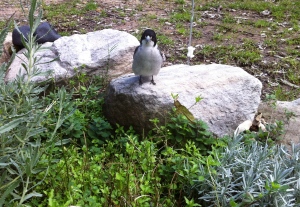
Sacred kingfisher couple.
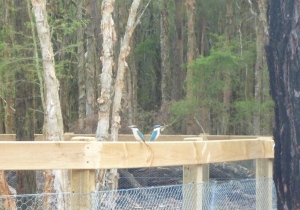
My pleasure in having wild bird company is enthusiastically shared by my kids. Whenever he spots any variety of feathered friend, Master J is quick to produce his generic bird call imitation, together with a repeating sign-language gesture (tapping pointer finger on thumb to resemble a moving bird beak). The infamous Indian Myna isn’t even spared such excitement. And Miss L at four can already identify and name many more birds than the average Australian. As well as being able to use her ears to determine what birds are about.
Pondering all this reminded me where my love of birds and the ability to identify them originated. I spent many a camping trip or bushwalk as a youngster, creeping about the bush with my mum, oldest brother and sister, binoculars at the ready and bird book on hand. The treasured binoculars, which I still own (despite the existence now of far superior models) were one of my earliest birthday gifts (I think I was six or seven) and they were proper adult ones. Not a toy version like the pair Miss L has. I was pretty thrilled to be trusted with using and maintaining such a special piece of equipment. (And of course the binoculars were not only used for spotting birds.)
I realise that bird-watching is not a hobby that’s enjoyed by the masses. You discover that fact quickly when you are frequently the only person around who doesn’t call every black and white bird a magpie or when others are surprised by your ability to make a distinction between a cockatoo and a corella. Bird-watching is perceived by some to be a pretty nerdy past-time too. But Bill Oddie is an avid bird-watcher! So it has got to be one of the coolest activities around. Right? He was always the hip one after all.
The whole process of seeking and identifying wild birds is just the perfect activity for kids. For a start it gets kids outdoors. It invites adventure but also teaches patience and listening. It helps kids learn to appreciate fine details and subtleties of an image, to differentiate colours and patterns, and distinguish shapes. Since bird-watching also incorporates bird sounds, it develops the sense of listening very well. There might be three or four different bird calls going on at once, but a bird-watcher learns to discern that one call and put a name and face to it. It’s a calming, quiet-time activity. We need lots of those up our sleeve as parents. And it involves challenge and achievement so it’s fantastic for kids’ self esteem.
If you’ve never done any bird watching before go on. Try it. With your kids. No matter how young they are. Grab a bird book. It doesn’t have to be the latest flash one…bird names haven’t changed that much over the years. I bought mine from the local charity store as you might have guessed. Get yourself a pair of binoculars if you’re keen. Though to start with, especially with young children, you don’t need them. Go outside! Even the most urban areas in Australia have birdlife so it’s not a prerequisite to be in the bush. But if you are that’s wonderful.
For some fabulous advice on bird watching as well as some excellent resources, check out the Birds in Backyards website. (Note: this is an Australian website, so it mostly relates to Australian birds but it does have general bird-watching advice too.) My best tips?
– Practise being still and quiet. Not only so you don’t frighten the little birdies but also to help you hear their calls and movements. Challenging for kids at first but you’d be amazed how easily this can be achieved once they realise the reward. Whispering and using hand signals to communicate when you’re on the bird hunt also adds to the fun.
– Observe a bird for as long as you can so you get to appreciate its size, shape, beak appearance, colours, patterns, calls and behaviour.
– Familiarise yourself with groups of birds and their features (eg, parrots, owls, wrens, kingfishers, honeyeaters). This will help when it comes to searching through pages for that one feathered friend amongst hundreds.
– Get to know your bird book. Most are divided into sections, with the first part usually providing very useful general information about bird identification and also a key to the different bird families.
– Take note of your location and utilise the distribution maps in the bird book. If you see a kookaburra in southern Australia it’s not going to be a blue-winged kookaburra unless it’s in an aviary.
– Keep a record book of birds you’ve identified. Kids will love this part. Keeping tabs on things is a favourite past-time of most kids. Younger kids can include drawings or photos.
The Birds in Backyards website keeps tabs too…on what birds are hanging around urban Australia. By becoming a member (no fee required) you can participate in some important surveys. Trust me it’s easy. And very rewarding.
Finally, here is a bird who you won’t need a book to identify: our non-native neighbourhood peacock (Mr Peacock to friends) who makes periodic appearances in our garden and never fails to put on a show. What a stunner. If anyone can inspire you to take up bird-watching with your kids, Mr Peacock can. Surely.

